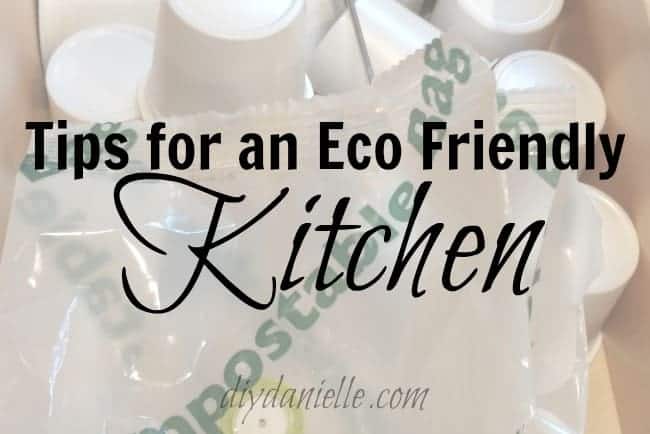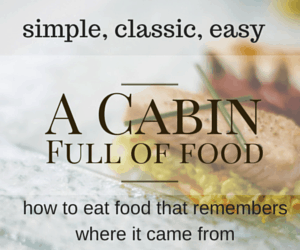
Tips for keeping an eco friendly kitchen: reducing our use of disposable products and our environmental footprint by adjusting how we cook and clean in one of the most waste-producing parts of our home.
This post may contain affiliate links which may earn me commissions should you click through them and take certain actions. As an affiliate for Amazon, Cricut, xTool, Home Depot, and other sites, I earn from qualifying purchases. Please DIY carefully. View my full legal disclosures here.
Please read the whole post so you don’t miss any important information!
The kitchen is one area that I’ve tried to be more and more mindful of how eco friendly I am. After all, a large portion of our household waste comes from the kitchen. Between bad food, paper towels, bones from meat, and more, the trash starts to pile up fast. Cutting down on this waste can substantially reduce your landfill contributions. Let’s talk about the how and why.
Disposing of Food Scraps
Often food scraps make up a good part of the kitchen garbage. It also smells up your garbage as it rots- which I’m not a fan of. Composting is a great way to go. The process can turn foods and other household waste into lovely compost for your garden. It certainly saves me a lot of money on soil additives.
I’ve got four posts on composting so I won’t repeat the info. But paper towels and napkins can be composted, along with a lot of food waste. If you’re interested, here are some posts with more in-depth information:
- Worm Composting
- Open Bin Composting
- Tumbling Compost Bins
- What you can and can’t put in your compost bin (with a free printable)
 Learning how to properly store and keep foods from rotting is also important. If you can’t buy an item in a small quantity, you can often freeze or can the food to save for another time.
Learning how to properly store and keep foods from rotting is also important. If you can’t buy an item in a small quantity, you can often freeze or can the food to save for another time.
My friend Marie wrote a great book, A Cabin Full of Food, that includes a lot of information on canning everything from meat to veggies. It also has a ridiculous number of really awesome recipes from lemon and vanilla extracts to casseroles. I highly recommend it. She lives without a refrigerator or freezer so she’s definitely a pro.
I’ve heard great things about canned meat- I really want to try it because I’ve had so many people tell me it’s awesome, but I need the equipment before I get started. Apparently lower quality cuts of meat are best to can (rather than freeze)… the canning process supposedly brings out the flavors. How cool is that? I didn’t even know meat could be canned before meeting Marie!
Food Packaging
I know some grocery stores have started to sell food without the packaging which is an ideal way to reduce waste, but I don’t know of any near me. That said, buying a bunch of oranges from the produce section and placing them in a reusable bag is better than buying the cut up oranges in the foam and plastic packaging.
For items that have packaging, it’s important to be aware of your local recycling rules and recycle accordingly. Clean out containers thoroughly before recycling them. Proper recycling cuts down on the recycling costs to your city… so do the best you can!
If you can, an even better option is upcycling the items. I love to reuse glass containers from jelly, pickles, etc.
Oh- and don’t forget your grocery bags! Reusable grocery bags are best, but paper bags are also a fairly ecofriendly choice because they can be composted, recycled, or upcycled. I used them for sewing patterns. We shop at Costco a lot so mostly I get stuff loose and have to haul each item in. I saw an idea recently to put laundry baskets in the back of the car for groceries- what an awesome idea! And way easier to carry it all in.
One nice thing about buying in bulk is that you can split the items down into smaller reusable containers. We have a big bucket for our rice, for example. I am guessing there’s a slightly smaller amount of packaging that goes to waste when you buy in bulk vs. buying the same amount of the product in many packages.
Replacing Disposable Kitchen Products
Napkins: We use cloth napkins in lieu of disposable ones. They’re pretty convenient. For kids, it’s nice to be able to wet them first without them falling apart. Buy Them
Silicone Muffin Pans or Baking Mats: I really like our silicone muffin pans and baking mats. The baking mats work well for cookies in lieu of parchment paper and the muffin pans or liners are pretty amazing too. Buy a Silicone Baking Mat / Buy Silicone Muffin Pan or Liners
Snack Bags: Reusable snack bags are a fun alternative to using a plastic bag. They’re also easy to wash in the laundry. Buy Them
Tupperware or Glass Storage Containers: Obviously these are great for storing food compared to plastic bags. Buy Them
Reusable Water Bottles: I have like… a million of these. I think I prefer the stainless steel or glass because they seem like they’d be longer lasting. But I could be wrong. Buy Them
Rechargeable Batteries: I’m not sure these are exactly a “kitchen” item but we keep ours in the kitchen. Not much to say about them. I also like items that don’t use batteries at all, but charge instead. Buy Them
Want to learn how to sew some of these reusable products like the refrigerator liners, unpaper towels, napkins, and more? Get my book, Sewing for Your Kitchen.
Coffee and the K-Cup Problem
At the moment, K-Cups are not eco friendly. At all. And Keurig has really seemed to intentionally prevent people from using cups that aren’t produced by them. It’s frustrating to me. We own a single cup coffee maker from Cuisinart that we’ve had a really long time with no issues. And we can get away with using K-Cups from other companies.
I know K-Cups can be upcycled, but they can’t be recycled from what I understand and they are a giant PITA to clean out. Giant. And really. How many K-Cup upcycling projects do you plan to do? It’s just not a super viable option for keeping them out of the landfill. Hopefully they’ll soon focus on more eco friendly alternatives.
In the meantime, you have options. You can get reusable k-cups that you fill with the coffee grounds of your choice. Much cheaper than k-cups! Alternatively, San Francisco Bay makes a mostly biodegradable k-cup. My husband LOVES the Donut Shop flavor of their coffee and we get it on subscribe and save from Amazon. I think it ends up being cheaper than K-Cups too, but don’t quote me. The “plastic” they have in their packaging is compostable. I usually cut the plastic top off the top of their cups, then throw the bottoms with the coffee grounds into our worm compost bin. I want to say the only part of their cup that isn’t compostable is the foil top, but I’m still weird about putting something that looks like plastic into my compost bin. I’m afraid it will take too long to break down. They are working hard to make it 100% biodegradable though. I’m just hoping they’re working hard to make their own chai latte k cup option!
Of course, a regular coffee maker is better. The coffee filters can be composted AND the coffee grounds are awesome for composting too.
Did I miss anything? How are you going eco friendly in your kitchen?

